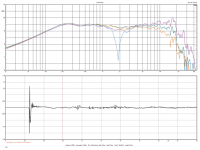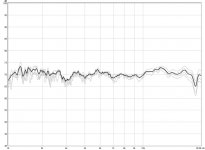i have just finished a project with Beyma TPL150-H, i think the vertical dispersion is disappointing and horizontal dispersion is not up there with the best too. However, it is a big tall AMT so something got to give with that 99db sensitivity....
Thanks Henry. What in particular did you find problematic about the horizontal disproportion?
Directivity aside, how did you like the sound compared to yourr horns? Perhaps it would work well with a small tweeter on top?
i have just finished a project with Beyma TPL150-H, i think the vertical dispersion is disappointing and horizontal dispersion is not up there with the best too. However, it is a big tall AMT so something got to give with that 99db sensitivity....
I can second that. TPL-150H gets narrow easily but it adds a huge amount of spaciousness to overall sound. you may consider Aurum Cantus G1 Ribbon as well
Last edited:
I can second that. TPL-150H gets narrow easily but it adds a huge amount of spaciousness to overall sound. you may consider Aurum Cantus G1 Ribbon as well
Are you using dipole? Have you tried monopole with enlarged rear chamber?
I think the Aurum Cantus AST2560 smaller format AMT would be a perfect match.
I got the Daytons but only had a few days to try them before going overseas. Initial impression is good. Benign: no need for eq, notch filters or whatevs. May take a while to get perfectly dialed in. They measure flat at the Mic position (about 1.5m) but sound a little hot (silbilant) at the listening position (3 or 4m).
Could be due to my setup / ears / preferences, or could be due to the length of diaphragm meaning less spl fall with distance than a point tweeter.
Note: they have similar power handling to a 1" compression driver, but lower efficiency. If you want to crank your system obscenely loud, they may be the weak link.
Could be due to my setup / ears / preferences, or could be due to the length of diaphragm meaning less spl fall with distance than a point tweeter.
Note: they have similar power handling to a 1" compression driver, but lower efficiency. If you want to crank your system obscenely loud, they may be the weak link.
I got the Daytons but only had a few days to try them before going overseas. Initial impression is good. Benign: no need for eq, notch filters or whatevs. May take a while to get perfectly dialed in. They measure flat at the Mic position (about 1.5m) but sound a little hot (silbilant) at the listening position (3 or 4m).
Could be due to my setup / ears / preferences, or could be due to the length of diaphragm meaning less spl fall with distance than a point tweeter.
Note: they have similar power handling to a 1" compression driver, but lower efficiency. If you want to crank your system obscenely loud, they may be the weak link.
Always one step ahead of me!
Don't like the sound of sibilance on a flat measuring tweeter...hopefully you can sort it out
Ps how's the Melbourne weather? I'm going for a conference there next week
I'm being a bit Special, in that I'm using them coaxially (in the mouth of a mid horn) and don't yet have the frames treated (felted) so it could actually be mid reflections, wrong amount of delay, anything.
The basic sound takes about two minutes to get right, so they seem like pretty good units, easy to work with. But in my current setup, the treble does draw too much attention on some kinds of music.
The basic sound takes about two minutes to get right, so they seem like pretty good units, easy to work with. But in my current setup, the treble does draw too much attention on some kinds of music.
I'm back and had some time to dial the system in with the Daytons (with mid horn and dual 15"). They are quite nice, so the weakest link in my system is now the midhorn to midbass transition. I think you'd have to have a very good / well honed system for the PRO4 to leave you wanting - or specific needs, like VERY high volume.
The big caveat is: you have to be happy with the narrow vertical dispersion. I think that's going to be true of any planar this size.
The big caveat is: you have to be happy with the narrow vertical dispersion. I think that's going to be true of any planar this size.
Havent heard the amts discussed, but I would expect the dispersion characteristics to be quite common among drivers with similar dimensions and opennings. Personally i seek controled dispersion given my modest listening areas. i get much flatter response at the listening location, and less reflected energy.
If you used the Dayton and not the TPL, I think you have done yourself an injustice. The TPL is in a different league as far as detail and transparency is concerned.
Interesting. Usually when I read something like this, I wonder how much the opinion is influenced by price / cachet / appearance / choice-supportive bias https://en.wikipedia.org/wiki/Choice-supportive_bias.
However, because I'm using a system that's configured similarly to the Volti Audio Alura which you praised recently, this tells me our tastes may be similar, so I'm more inclined to pay attention.
How did you do your comparison?
Was it A-B testing, with comparing the Dayton and TPL in the same system, where only these components were changed (and level matched), or were you comparing system A with the Dayton to system B with the TPL?
Are you able to point to a defined characteristic (e.g. less distortion under 3,000 Hz) that separates the two drivers, or is it a bit vaguer than this?
I dont know about sound of the daytons but the Mundorf tweeters are an absolute breeze to integrate vs. The pair of daytons i tried to use as an experiment based on published frd and zma files. bass extension, flatness and power handling are superb in the mundorfs. the daytons, not so much.
I dont know about sound of the daytons but the Mundorf tweeters are an absolute breeze to integrate vs. The pair of daytons i tried to use as an experiment based on published frd and zma files. bass extension, flatness and power handling are superb in the mundorfs. the daytons, not so much.
Can "not so much" be clarified?
Again, are you able to point to defined characteristics (e.g. less distortion under 3,000 Hz) that separates the drivers, or is it a bit vaguer than this?
Also, was it an apples-to-apples comparison? Are you talking about the PRO4 vs. a similar sized Mundorf, in the same system?
BASS EXTENSION - how much bass extension does a tweeter need?
The OP and I are both using multi-way systems (3- or 4-way) built around 2" midhorns. We both have working JBL 2445J drivers.
The Daytons seem perfectly capable when crossed at 2kHz, the lowest I've tried them. Paying 5 times as much to get response that goes lower than 2kHz seems like a waste, for this application.
FLATNESS - how flat is flat? Note that the OP and I are using DSP.
Attached is the PRO4 measured in-room at about 2m, no IR gating, 1/48 smoothing. The raw response humps around 10kHz, so I have used some smiley face eq, but no notches. I moved the mic ~5cm up and across between measurements (that is: much less than the ear-to-ear distance), and took the average, to show how much of the deviation is room/position related, and how much is inherent.
- The top octave looks good, but is very position sensitive.
- It has a consistent -2dB dip at 4kHz.
- The dip changes if I fiddle with the number and position of felt pads in the rear of the unit. Presumably it is a cavity resonance, and can be reduced with correct damping.
- Moving by 5cm, or changing a room reflection (e.g. closing a door) can create much bigger dips - about 5dB - which shows the relative insignificance of a 2dB aberration.
Do the Mundorf units have less than 2dB variation when measured in-room?
POWER HANDLING: On paper, this is the weak point of the PRO4. Some of the more expensive Mundorf units are specified as having both more power handling and more sensitivity, which should mean ~8dB increase in max SPL. For pro use, that's significant.
For my domestic use, the power handling of the PRO4 is ample. Using a 2kHz crossover and one speaker, it sounds clean when playing at an uncomfortably loud level (too loud for long-term listening), at a distance of 4m. I have no idea how much louder I could potentially have cranked it.
When I reduced that level by -10dB, and went two rooms away to get a drink, I realised that the music was still playing too loudly - it was probably loud enough to disturb my neighbors.
Setting the other channel up, and bumping the crossover up to 4 or 5kHz, should give me about 10dB more headroom, if I needed it. So I know I can play music at least 20dB louder than is polite, in a suburban setting. I reckon that's enough.
This is all genuine inquiry. I am honestly curious how one describes driver A as clearly better than driver B, when the 'inferior' driver is of the same size and type, measures well and seems very well suited to the application.
PS - In a couple of weeks I won't have a horse in this race - I'm moving to an apartment, so will be storing the experimental rig and scaling back to my small system, 15" coaxials
Attachments
Hi hollow,
Sorry for the confusion.
No problem. It was a good excuse to think out loud, which often helps clarify goals, etc.
- Status
- This old topic is closed. If you want to reopen this topic, contact a moderator using the "Report Post" button.
- Home
- Loudspeakers
- Multi-Way
- Beyma TPL vs other AMT's

